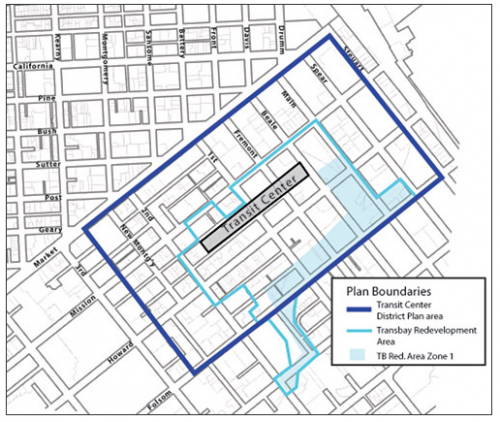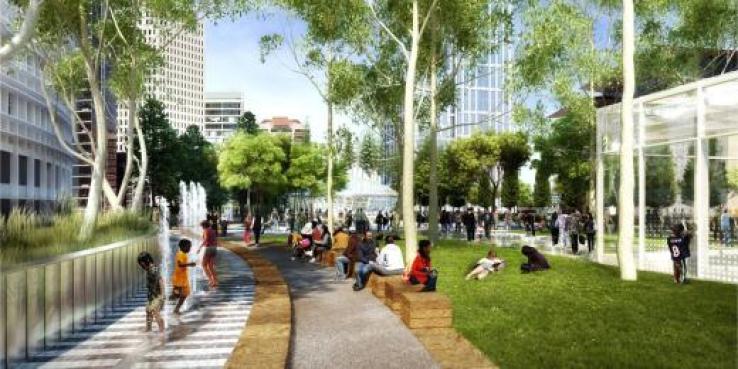Update: Mayor Ed Lee signed the Transit Center District Plan into passage on August 8, after unanimous approval by the San Francisco Board of Supervisors.
Things are heating up again for San Francisco's Transit Center District Plan. On May 24, the SF Planning Commission voted 5-1 to certify the final draft of the environment impact report that will move the plan forward to the Board of Supervisors’ Land Use and Economic Development Committee. In addition, the commission voted to approve amendments to the general plan, planning code and zoning code that will be necessary to implement the plan. It will go before the Board of Supervisors for adoption sometime in July. SPUR has long supported this plan, recognizing its potential to transform San Francisco and the region.
What Is the Transit Center District Plan?
The Transit Center District consists of approximately 145 acres surrounding the new Transbay Transit Center, currently under construction on Mission Street between First and Fremont.

The plan aims to create a new downtown neighborhood made up primarily of office and retail space, with a notable amount of residential space as well. The plan will enhance the area’s established patterns of land use, urban form and public space, creating a vibrant new neighborhood.The Transbay Joint Powers Authority (TJPA) selected Pelli Clarke Pelli Architects and developer Hines to design and build a high-rise tower next to the new terminal. The team has proposed a 1,070-foot tower, the tallest in the city. There are several shorter towers proposed for the district, ranging in height from 150 to 850 feet. These towers will provide major sources of new job space and housing over the coming decades.The Transbay Transit Center, the centerpiece of the plan, will not only provideexpanded bus facilities, itwill also include an underground rail station to serve as the San Francisco terminus for Caltrain and California high-speed rail. Because the project is not fully funded, the TJPA has divided its construction into two phases: the above ground terminal and the undergroundextension of Caltrainfrom its current station at 4th and King streets. (Note: Gabriel Metcalf, SPUR’s executive director, is a member of the Transbay Joint Powers Authority, the governing body for the transit station construction project.)
Why Downtown?
The downtown core can, and should, absorb more jobs and housing. Since the California Legislature adopted Assembly Bill 32, which mandates statewide reductions in greenhouse gas emissions, and Senate Bill 375, which requires regions to adopt land use plans that will bring about these reductions, there has been increasing momentum to encourage transit-oriented development around the state. San Francisco had already designated a redevelopment area adjacent to the Transit Center that calls for 2,700 units of housing (with 35 percent of it affordable). The new Transit Center District Plan, which overlaps some with the redevelopment area, will add zoning for a total of about 9 million square feet of space, of which about 6 million is anticipated to be office space. That’s an increase of about 33 percent and enough to provide nearly 35,000 jobs. As highlighted in SPUR’s report The Future of Downtown San Francisco, downtown is the logical place for dense employment near transit. The Transit Center District Plan brings these principles to life.
Costs and Public Benefits
To achieve the plan’s objectives and create the district envisioned, a broad range of public improvements and related programs are needed. The budget for the entire Transit Center and district are projected at $4.2 billion.
Approval of the Transit Center District Plan will provide much needed funding for the extension of regional rail to downtown San Francisco and other public infrastructure improvements. The Transit Center District Plan will also provide $590 million through a new neighborhood that has been zoned to generate fees for the city. To achieve the plan’s vision, development projects must generate enough funding to pay for infrastructure and public improvements proposed in the plan. Two proposed funding mechanisms are intended to strike the balance to achieve these requisites. First the city assessed new impact fees to be paid by developers who build in the district. Second, the area will establish a Mello-Roos Community Facilities District for new development projects, which will levy additional property taxes to pay for neighborhood improvements. Of the revenues projected to be raised from building out the plan, up to $420 million would be available for the Transit Center and rail extension, and $170 million would go to street and open space improvements to support growth in the district. Currently, a 5.4-acre park is planned atop the Transbay Transit Center. Making this park publically accessible is a critical element of the plan’s objectives for increasing open space. The plan also calls for more pedestrian and bike improvements, as well as sidewalk and street improvements to further solidify this as a viable neighborhood and jobs center.
This plan area has long been one of SPUR’s top priorities. It will be a national model of transit-oriented development. For urban design reasons, environmental reasons and economic reasons, we think this is the right plan in the right location.
